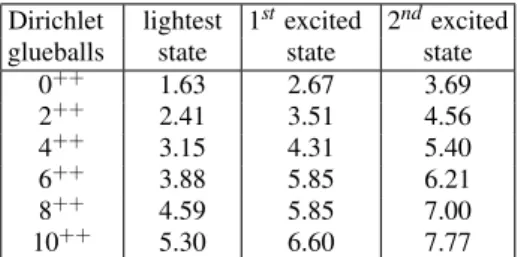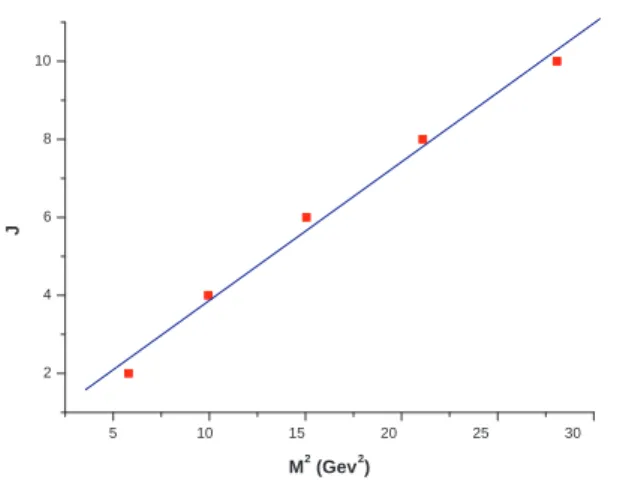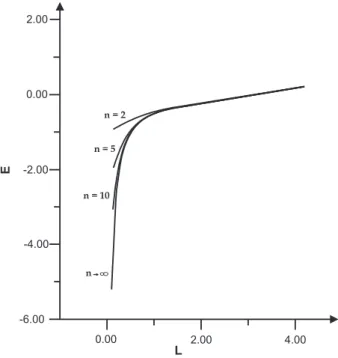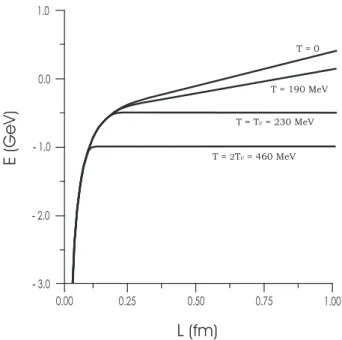Strong Interactions and Gauge-String Duality
Henrique Boschi-Filho and Nelson R. F. Braga
Instituto de F´ısica, Universidade Federal do Rio de Janeiro, Caixa Postal 68528, RJ 21941-972 – Brazil (Received on September 15, 2006)
We discuss some recent phenomenological models for strong interactions based on the idea of gauge/string duality. A very good estimate for hadronic masses can be found by placing an infrared cut off in AdS space. Considering static strings in this geometry one can also reproduce the phenomenological Cornell potential for a quark anti-quark pair at zero temperature. Placing static strings in an AdS Schwarzschild space with an infrared cut off one finds a transition from a confining to a deconfining phase at some critical horizon radius (associated with temperature).
Keywords: AdS/CFT; String theory; QCD
I. INTRODUCTION
In this review we are going to discuss some recent phe-nomenological results concerning the relation between string theory and QCD inspired in this idea of introducing an in-frared cut off in anti-de Sitter (AdS) or in Schwarzschild-AdS spaces. QCD has been tested and confirmed with success in high energy experiments but it is non perturbative at low ener-gies. Lattice calculations give us very important results in this regime. However it seems that we are still far from a complete description of the complexity of strong interactions. In partic-ular, important aspects like confinement and mass generation still lack a satisfactory description. Presently there are many indications that string theory can be useful in the description of strong interactions in the non perturbative regime of QCD. An early connection between SU(N) gauge theories (for large N) and string theory was realized long ago by ’t Hooft[1]. A few years ago a very important result was ob-tained by Maldacena[2]. He established a correspondence be-tween string theory inAdS5×S5space-time and
N
=4 super-conformal Yang Mills SU(N) theory for large N at its four di-mensional boundary, known as AdS/CFT correspondence[2– 4].In the AdS/CFT correspondence there is an exact duality between a four dimensional gauge theory and string theory in a ten dimensional space. However, in this formulation, the gauge theory has no energy scale as it is conformal. Although it involves a conformal gauge theory, the AdS/CFT corre-spondence has been a very important source of inspiration for searching QCD results from string theory. The first idea of breaking conformal invariance in the AdS/CFT context, pro-posed by Witten, is to consider an AdS Schwarzschild black hole as dual to a non-supersymmetric Yang Mills theory[5]. This approach was used to calculate glueball masses in [6– 12].
II. QCD SCATTERING AND STRING THEORY
A very important result relating string theory to the behav-ior of scattering amplitudes for high energy processes at fixed angles was found by Polchinski and Strassler[13]. In this regime, that corresponds, in terms of Mandelstam variables, tos→∞ with s/t fixed, the Veneziano amplitude coming
from string theory in flat space shows a soft scattering behav-ior
AVen. ∼exp{−α′s f(θ)}, (1) whereθis the scattering angle andα′is related to the string
tension. In contrast, it was known for a long time that hadronic scattering amplitudes for processes in this regime show a hard scattering behavior, as reproduced by QCD[14, 15]. That means, the amplitudes fall of with a negative power of s. Polchinski and Strassler found a solution to this apparent ob-stacle in the description of strong interactions by string theory considering the duality between gauge theory glueballs and string theory dilatons in an AdS space with an infrared cut off. This way they found the QCD hard scattering behaviour for high energy amplitudes at fixed angles.
The hard scattering behavior was also obtained afterwards in [16] from a mapping between quantum states in AdS space and its boundary found in [17]. We considered an AdS slice as approximately dual to a confining gauge theory. The slice corresponds to the metric
ds2= R 2
(z)2 ³
dz2+ (d~x)2−dt2´, (2) with 0≤z≤zmax ∼1/µwhereµis an energy scale chosen as
the mass of the lightest glueball. We used a mapping between Fock spaces of a scalar field in AdS space and operators on the four dimensional boundary, defined in [17]. Considering a scattering of two particles intomparticles one finds a relation between bulk and boundary scattering amplitudes[16]
SBulk ∼SBound.
³√α′ µ
´m+2
K(m+2)(1+d) (3) whered is the scaling dimension of the boundary operators andK is the boundary momentum scale. This leads to the result for the amplitude
ABoundary ∼s(4−∆)/2, (4)
where∆is the total scaling dimension of scattered particles. This reproduces the hard scattering behavior.
III. SCALAR GLUEBALL MASSES
Using the phenomenological approach of introducing an energy scale by considering an AdS slice we found estimates for scalar glueball mass ratios[25, 26]. In the AdS5bulk we took dilaton fields satisfying Dirichlet boundary conditions at z=zmax
Φ(z,~x,t) =
∞
∑
p=1
Z d3k
(2π)3
z2J2(u
pz)
zmaxwp(~k)J3(upzmax)
× {ap(~k)e−iwp(
~k)t+i~k·~x +h.c.
},
wherewp(~k) =
q u2
p+~k2,
up=
χ2,p zmax
, (5)
is the momentum associated with thezdirection andχ2,p are the zeroes of the Bessel functions: J2(χ2,p) =0.
On the boundary (z = 0) we considered scalar glue-ball states JPC = 0++ and their excitations 0++∗,0++∗∗ with masses µp,p =1,2, .... Assuming an approximate
gauge/string duality the glueball masses are taken propor-tional to the dilaton discrete modes:
up
µp
=const.
So, the ratios of glueball masses are related to zeroes of the Bessel functions
µp
µ1
= χ2,p χ2,1
.
Note that these ratios are independent of the size of the slice zmax. Our estimates are in good agreement with the available
lattice[27, 28] and AdS-Schwarzschild [6] results. For a de-tailed comparison see refs. [25, 26].
For some other results concerning glueball masses using gauge/string duality see for instance [29–33].
IV. HIGHER SPIN STATES AND REGGE TRAJECTORIES
Recently, very interesting results for the hadronic spectrum were obtained by de Teramond and Brodsky[34] considering scalar, vector and fermionic fields in a slicedAdS5×S5space. It was proposed that massive bulk states corresponding to fluc-tuations about the AdS5metric are dual to QCD states with angular momenta (spin) on the four dimensional boundary. This way the spectrum of light baryons and mesons has been reproduced from a holographic dual to QCD inspired by the AdS/CFT correspondence.
We used a similar approach to estimate masses of glueball states with different spins[35]. The motivation was to com-pare the glueball Regge trajectories with the pomeron trajec-tories. For soft pomerons [36] experimental results show that the spinJof the pomeron is
J≈1.08+0.25M2 , (6)
Dirichlet lightest 1stexcited 2ndexcited glueballs state state state
0++ 1.63 2.67 3.69
2++ 2.41 3.51 4.56
4++ 3.15 4.31 5.40
6++ 3.88 5.85 6.21
8++ 4.59 5.85 7.00
10++ 5.30 6.60 7.77
TABLE I: Higher spin glueball masses in GeV with Dirichlet bound-ary condition. The value 1.63 is an input from lattice.
Neumann lightest 1stexcited 2ndexcited glueballs state state state
0++ 1.63 2.98 4.33
2++ 2.54 4.06 5.47
4++ 3.45 5.09 6.56
6++ 4.34 6.09 7.62
8++ 5.23 7.08 8.66
10++ 6.12 8.05 9.68
TABLE II: Higher spin glueball masses in GeV with Neumann boundary condition. The value 1.63 is an input from lattice.
whereM is the mass in GeV. It is conjectured that the soft pomerons may be related to glueballs. Recent lattice results are consistent with this interpretation[37].
We assume that massive scalars in the AdS slice with mass µare dual to boundary gauge theory states with spinJrelated by:
(µR)2=J(J+4). (7) We consider both Dirichlet and Neumann boundary condi-tions and the results for the four dimensional glueball masses with even spin are shown in tables I and II respectively.
We found non linear relations between spin and mass squared. We considered linear approximations representing Regge trajectories
J=α0+α′M2. (8)
For Dirichlet boundary conditions, taking the statesJ++ with J=2,4, ...,10 we found a linear fit with
α′ = (0.36±0.02)GeV−2 ; α0=0.32±0.36, (9) as shown in Figure 1.
For Neumann boundary conditions for the statesJ++withJ= 2,4, ...,10 we found
α′ = (0.26±0.02)GeV−2 ; α0=0.80±0.40, (10) as shown in Figure 2.
5 10 15 20 25 30 2
4 6 8 10
J
M2 (Gev2)
FIG. 1: Spin versus mass squared for the lightest glueball states with Dirichlet boundary conditions from table I. The line corresponds to the linear fit.
5 10 15 20 25 30 35 40
2 4 6 8 10
M2 (GeV2)
J
FIG. 2: Spin versus mass squared for the lightest glueball states with Neumann boundary conditions from table II. The line corresponds to the linear fit.
V. WILSON LOOPS AND QUARK ANTI-QUARK POTENTIAL
Wilson loops are an important tool to discuss confinement in gauge theories since they show the behavior of the energy associated with a given field configuration. In the AdS/CFT correspondence Wilson loops for a heavy quark anti-quark pair in the gauge theory can be calculated from a static string in the AdS space[39, 40]. The corresponding energy is a non confining Coulomb potential as expected for a conformal the-ory. For an excellent review and extension to other metrics see [41]. We calculated Wilson loops for a quark anti-quark pair in D3-brane space finding different behaviors, with respect to confinement, depending on the quark position[42].
The static potential energy of a heavy quark anti-quark pair
is described by the phenomenological Cornell potential
ECornell(L) = −
4 3 a
L +σL+constant, (11) wherea=0.39 andσ=0.182GeV2.
The metric (2) of the AdS space can be rewritten as
ds2=³r 2
R2 ´
(−dt2+d~x2) +³R 2
r2 ´
dr2, (12) where r=R2/z. We have calculated the energy of a static string in an AdS slice defined byr2≤r≤r1[43]. The quark anti-quark pair (string endpoints) is located atr=r1, sepa-rated by a four dimensional (x coordinates) distanceL and there is an infrared cut off in the space atr=r2. From now on we chooser2=R. Note that there are two kinds of geodesics, as shown in figure 3, depending on the value ofL. For small quark separationL≤Lcrit the geodesics are curve (like curve a) with one minimum value of the coordinater=r0which is related toLby
L(r0) = 2R 2
r0
I1(r1/r0) (13)
whereI1(ξ)is the elliptic integral
I1(ξ) =
Z ξ
1
dρ ρ2p
ρ4−1. (14) The critical value corresponds toLcrit=L(r0=R)as in curve
bof figure 3.
The energy forL≤Lcrit can be calculated as
E(−) = 2R 2
πα′
I1(r1/r0) L
h
I2(r1/r0)−1 i
. (15) where 1/2πα′is the string tension and we have subtracted the
constantr1/πα′ in such a way that the energy is finite even in the limitr1→∞. The integralI2is
I2(ξ) =
Z ξ
1
h ρ2 p
ρ4−1 −1 i
dρ. (16)
For L>Lcrit, the geodesics reach the infrared brane as
shown in curvecof figure 3. The energy can be calculated again subtracting the constant r1/πα′, associated with the quark mass. We obtain
E(+) = 2R 2
πα′
I1(r1/r0) L
h
I2(r1/r0)−I2(R/r0) i
− παR′ + L
2πα′
I1(R/r0) I1(r1/r0)
✻
−Lcrit/2
+Lcrit/2 x
• •
•
• •
• b
a c
✲
r
r=r1
r=r2
FIG. 3: Schematic representation of geodesics in the AdS slice.
Taking the limitr1→∞, we find a potential which is ap-proximately Coulombian for smallLand has a leading linear confining behavior for large distances
E(+) ∼ 1
2πα′L. (18)
The identification of this potential energy with the Cornell po-tential leads to
a =3C12R2/2πα′ ; σ= 1
2πα′ (19)
withC1 = √
2π3/2/[Γ(1/4)]2. So that we find an effective AdS radiusR=1.4 GeV−1. Then the energy takes the form
E(−) = −4a
3L, L≤Lcrit (20)
E(+) = −4a 3L +
4a 3C1L
h
1−I2(R/r0)i
− s
4aσ 3C21 +σL
I1(R/r0) C1
, L≥Lcrit (21)
The shape of this potential energy is very similar to the Cor-nell potential as shown in figure 4.
VI. QUARK ANTI-QUARK POTENTIAL AT FINITE TEMPERATURE
A gauge/string duality involving a gauge theory at finite temperature was proposed by Witten in [5] inspired by the
FIG. 4: Energy in GeV as a function of string end-points separation Lin GeV−1, for AdS slices withr1=nRandr2=R. Forn→∞the
energy behaves as the Cornell potential eq. (11).
work of Hawking and Page[44]. In this approach, for high temperatures, the AdS space accommodates a Schwarzschild black hole and the horizon radius is proportional to the tem-perature. For low temperatures the dual space would be an AdS space with compactified time dimension, known as ther-mal AdS. The gauge string duality using AdS Schwarzschild space has recently been applied to obtain the viscosity of a quark gluon plasma[45, 46].
In ref. [47] we considered an AdS Schwarzschild black hole metric as a phenomenological model for a space dual to a theory with both mass scale and finite temperature. The corresponding metric is
ds2=³r 2
R2 ´
(−f(r)dt2+d~x2) +³R 2
r2 ´ 1
f(r)dr
2+R2d2Ω5, (22) wherer2≤r<∞, f(r) =1−rT4/r4 and the horizon radius
rT is related to the Hawking temperature byrT =πR2T. At
zero temperature this space becomes an Anti-de Sitter (AdS) slice. The problem of static strings in a space with metric (22), without any cut off, was discussed in detail in[48, 49].
FIG. 5: Energy as a function of string end-points separation for dif-ferent temperatures.
confined. The critical temperatureTC corresponds torT =r2.
As in the zero temperature case we choose r2=R from now on. We show in figure 5 the energies obtained in [47] for temperaturesT =0,T =0.8TC,T =TC and T =2TC. This
figure illustrates the fact that in our model the energy of static strings associated with the quark anti-quark potential present a confining behavior for temperatures belowTC =1/πR. In
this case there is a linear term in the energy, for large quark distancesL given by E∼σ(T)Lwith
σ(T) = 1 2πα′
q
1−(πRT)4 (T<T
C). (23)
At zero temperature this coefficient is identified with the string tension of the Cornell potential 1/(2πα′) =0.182 Gev2. For temperaturesT ≥TCthere is no confinement since the energy
is finite whenL→∞. Choosing the brane position to have the valueR=1.4 GeV−1 as in the zero temperature case[43] we find a critical temperatureTC ∼230MeV .
Our results agree qualitatively with lattice calculations for QCD at finite temperature [50–53]. However, it is important to mention that the results from fluctuations of strings in flat space at finite temperature[54] and from lattice calculations[55] imply corrections to the string tension of or-der −T2 at low temperatures, while our model predicts cor-rections of order−T4, as can be seen from eq. (23). If we had considered the thermal AdS metric for low temperatures, instead of the AdS Schwarzschild black hole metric, we would get no thermal corrections to the string tension. It would be in-teresting to find a holographic phenomenological model that gives the expected low temperature corrections. It is worth mentioning the recent articles [56] and [57] that also discuss thermal effects in the gauge/string duality context. There is also a very recent result by Herzog[58] which indicates that the dual space for temperatures belowTC should be the
ther-mal AdS.
For other interesting results concerning gauge/string duality and QCD see for instance [59–69].
Acknowledgments
We would thank Silvio Sorella and the organizers of “In-frared QCD in Rio”, where this talk was presented, for the very warm atmosphere during the workshop. We thank also Michael Teper and Andrei Starinets for very interesting dis-cussions about the finite temperature case. The authors are partially supported by CNPq and Faperj.
[1] G. ’t Hooft, Nucl. Phys. B72, 461 (1974).
[2] J. Maldacena, Adv. Theor. Math. Phys.2, 231 (1998).
[3] S. S. Gubser , I.R. Klebanov and, A.M. Polyakov, Phys. Lett. B 428, 105 (1998).
[4] E. Witten, Adv. Theor. Math. Phys.2, 253 (1998). [5] E. Witten, Adv.Theor.Math.Phys.2, 505 (1998).
[6] C. Csaki, H. Ooguri, Y. Oz, and J. Terning, JHEP9901, 017 (1999).
[7] R. de Mello Koch, A. Jevicki, M. Mihailescu, and J. P. Nunes, Phys. Rev. D58, 105009 (1998).
[8] A. Hashimoto, Y. Oz, Nucl. Phys. B548, 167 (1999).
[9] C. Csaki, Y. Oz, J. Russo, J. Terning, Phys. Rev. D59, 065012 (1999).
[10] J. A. Minahan, JHEP9901, 020 (1999).
[11] C. Csaki, J. Terning, AIP Conf. Proc.494, 321 (1999). [12] R. C. Brower, S. D. Mathur, and C. I. Tan, Nucl. Phys. B587,
249 (2000).
[13] J. Polchinski and M. J. Strassler, Phys. Rev. Lett.88, 031601 (2002).
[14] V. A. Matveev, R. M. Muradian, and A. N. Tavkhelidze, Lett.
Nuovo Cim.7, 719 (1973).
[15] S. J. Brodsky and G. R. Farrar, Phys. Rev. Lett31, 1153 (1973); Phys. Rev. D11, 1309 (1975).
[16] H. Boschi-Filho and N. R. F. Braga, Phys. Lett. B560 232 (2003).
[17] H. Boschi-Filho and N. R. F. Braga, Phys. Lett. B525, 164 (2002).
[18] S. B. Giddings, Phys. Rev. D67, 126001 (2003). [19] R. C. Brower, C. I. Tan, Nucl. Phys. B662, 393 (2003). [20] O. Andreev, Phys. Rev. D67, 046001 (2003).
[21] J. Polchinski and M. J. Strassler, JHEP0305, 012 (2003). [22] S. J. Brodsky and G. F. de Teramond, Phys. Lett. B582, 211
(2004).
[23] O. Andreev, Phys. Rev. D70, 027901 (2004). [24] O. Andreev, Phys. Rev. D71, 066006 (2005).
[25] H. Boschi-Filho and N. R. F. Braga, Eur. Phys. J. C32, 529 (2004).
[26] H. Boschi-Filho and N. R. F. Braga, JHEP0305, 009 (2003). [27] C. J. Morningstar and M. Peardon, Phys. Rev. D 56, 4043
[28] M.J. Teper, ”Physics from lattice: Glueballs in QCD; topology; SU(N) for all N ”, arXiv:hep-lat/9711011.
[29] E. Caceres and R. Hernandez, Phys. Lett. B504, 64 (2001). [30] R. Apreda, D. E. Crooks, N. Evans, and M. Petrini, JHEP0405,
065 (2004).
[31] X. Amador and E. Caceres, JHEP0411, 022 (2004). [32] M. Schvellinger, JHEP0409, 057 (2004).
[33] E. Caceres and C. Nunez, JHEP0509, 027 (2005).
[34] G. F. de Teramond and S. J. Brodsky, Phys. Rev. Lett. 94, 201601 (2005).
[35] H. Boschi-Filho, N. R. F. Braga, and H. L. Carrion, Phys. Rev. D73, 047901 (2006).
[36] P. V. Landshoff, “Pomerons,”, published in “Elastic and Difrac-tive Scattering” Proceedings, Ed. V. Kundrat and P. Zavada, 2002, arXiv:hep-ph/0108156.
[37] H. B. Meyer and M. J. Teper, Phys. Lett. B605, 344 (2005). [38] L. Randall and R. Sundrum, Phys. Rev. Lett.83, 3370 (1999);
ibid.83, 4690 (1999).
[39] S. J. Rey and J. T. Yee, Eur. Phys. J. C22, 379 (2001). [40] J. Maldacena, Phys. Rev. Lett.80, 4859 (1998).
[41] Y. Kinar, E. Schreiber and J. Sonnenschein, Nucl. Phys. B566, 103 (2000).
[42] H. Boschi-Filho and N. R. F. Braga, JHEP0503, 051 (2005). [43] H. Boschi-Filho, N. R. F. Braga, and C. N. Ferreira, Phys. Rev.
D73, 106006 (2006).
[44] S. W. Hawking and D. N. Page, Commun. Math. Phys.87, 577 (1983).
[45] G. Policastro, D. T. Son, and A. O. Starinets, Phys. Rev. Lett. 87, 081601 (2001).
[46] P. Kovtun, D. T. Son, and A. O. Starinets, Phys. Rev. Lett.94, 111601 (2005).
[47] H. Boschi-Filho, N. R. F. Braga, and C. N. Ferreira, Phys. Rev. D74, 086001 (2006). .
[48] S. J. Rey, S. Theisen, and J. T. Yee, Nucl. Phys. B527, 171 (1998).
[49] A. Brandhuber, N. Itzhaki, J. Sonnenschein, and S. Yankielow-icz, Phys. Lett. B434, 36 (1998).
[50] O. Kaczmarek, F. Karsch, E. Laermann, and M. Lutgemeier, Phys. Rev. D62, 034021 (2000).
[51] O. Kaczmarek, F. Karsch, P. Petreczky, and F. Zantow, Phys. Lett. B543, 41 (2002).
[52] O. Kaczmarek, F. Karsch, F. Zantow, and P. Petreczky, Phys. Rev. D70, 074505 (2004) [Erratum-ibid. D72, 059903 (2005)]. [53] P. Petreczky, Eur. Phys. J. C43, 51 (2005).
[54] R. D. Pisarski and O. Alvarez, Phys. Rev. D26, 3735 (1982). [55] P. de Forcrand, G. Schierholz, H. Schneider, and M. Teper,
Phys. Lett. B160, 137 (1985).
[56] K. Ghoroku and M. Yahiro, Phys. Rev. D73, 125010 (2006). [57] O. Andreev and V. I. Zakharov, “The Spatial String
Ten-sion, Thermal Phase Transition, and AdS/QCD,” arXiv:hep-ph/0607026.
[58] C. P. Herzog, “A holographic prediction of the deconfinement temperature,” arXiv:hep-th/0608151.
[59] R. A. Janik and R. Peschanski, Nucl. Phys. B625, 279 (2002). [60] L. A. Pando Zayas, J. Sonnenschein, and D. Vaman, Nucl. Phys.
B682, 3 (2004).
[61] O. Andreev and W. Siegel, Phys. Rev. D71, 086001 (2005). [62] F. Bigazzi, A. L. Cotrone, L. Martucci, and L. A. Pando Zayas,
Phys. Rev. D71, 066002 (2005).
[63] J. Erlich, E. Katz, D. T. Son, and M. A. Stephanov, Phys. Rev. Lett.95, 261602 (2005).
[64] L. Da Rold and A. Pomarol, Nucl. Phys. B721, 79 (2005). [65] N. Evans, J. P. Shock, and T. Waterson, Phys. Lett. B622, 165
(2005).
[66] T. Hambye, B. Hassanain, J. March-Russell, and M. Schvel-linger, Phys. Rev. D74, 026003 (2006).
[67] R. Casero, C. Nunez, and A. Paredes, Phys. Rev. D73, 086005 (2006).
[68] S. J. Brodsky and G. F. de Teramond, AIP Conf. Proc.814, 108 (2006). [arXiv:hep-ph/0510240].



